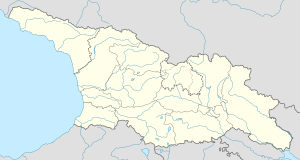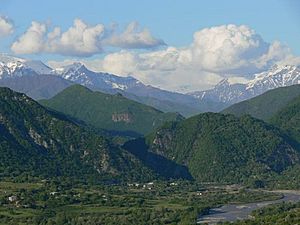Gebi, Georgia facts for kids
Quick facts for kids
Gebi
ღები
|
|
|---|---|
| Country | |
| Region | Racha-Lechkhumi and Kvemo Svaneti |
| Municipality | Oni |
| Elevation | 1,350 m (4,430 ft) |
| Population
(2014)
|
|
| • Total | 296 |
| Time zone | UTC+4 (Georgian Time) |
Gebi (pronounced Ghe-bee) is a very old village in the northern part of Georgia. It's located in the Racha region, close to the Caucasus Mountains and the border with Russia. The name Gebi comes from the Svan language and means "depression," probably because of how it sits among the mountains. Gebi, along with two other villages, Chiora and Glola, forms a special cultural area called Mtaracha. This area covers about 355 square kilometers.
Contents
Ancient Discoveries in Gebi
The village of Gebi has a very long and interesting history. People have lived here for more than 3500 years! During the Soviet era, archaeologists dug up an ancient burial ground, called a necropolis, in a place called Brili.
Early Settlements and Metalworking
The oldest things found there are from the Middle Bronze Age. This shows that people lived in this part of Racha even earlier. This area, on the southern side of the Caucasus Mountains, was one of the first places in the ancient world to work with metals. The metal products made here were traded and sent to other parts of the Caucasus and Georgia.
Trade and Connections in Ancient Times
Life in Gebi continued to thrive into the Late Bronze Age and early Iron Age. The things archaeologists found from this time are similar to items from the Colchian and Koban cultures. Later, in ancient times, Gebi had strong trade connections with Greek cities along the Black Sea. Some discoveries from this period even show links to ancient Egypt and the Scythian world.
In the Middle Ages, the Mtaracha area (which includes Gebi, Chiora, and Glola) was part of a region called Dvaleti. Then, it became part of Svanetia. By the early 1500s, it joined the Racha principality.
Gebi's Cultural Journey
Christianity began to spread in this area around the 300s AD. The oldest churches found here were built between the 800s and 900s. It's a bit tricky to figure out if this part of Georgia belonged to Racha, Svanetia, or Dvaleti long ago. Until the 1500s, Racha, Svanetia, and Dvaleti were all part of one large area known as a Duchy of Georgia.
Changes in Borders and Names
However, in the 1500s, these regions separated. Racha and Dvaleti became one principality, while Svanetia became another. Later, in the 1800s, the historic Dvaleti region, which includes today's Nari gorge and an old settlement called Nar, became part of Russia. Because of political problems in Georgia after some revolts, this historic part of Racha also became part of Russia, specifically the North Ossetian Autonomous Republic.
Mta-Racha was often a place where Rachians, Dvaletians, and Svans had disagreements. But in the end, it was considered part of the Rachian Duchy. The name of the nearby settlement, Chiora, comes from a word in the Rachian dialect. A legend says that the first people of Chiora lived deeper in the Caucasus mountains. They faced pressure from other groups, so they asked the people of Gebi if they could settle nearby. When they arrived, they asked if there were any "Cioreuli" (meaning mammals like bears or deer) in the area. Because of this, the new settlers called the place Chiora, or "the place where the mammals are."
See also
 In Spanish: Guebi para niños
In Spanish: Guebi para niños



